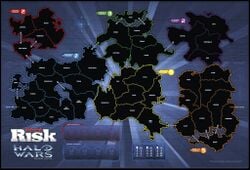Halopedia:Sandbox: Difference between revisions
From Halopedia, the Halo wiki
BaconShelf (talk | contribs) Tags: Blanking Rollback |
Postmortem (talk | contribs) No edit summary Tag: Reverted |
||
| Line 1: | Line 1: | ||
==Overview== | |||
===Astronomical features=== | |||
Arcadia is a tropical planet orbiting the star [[Procyon]],{{Ref/Reuse|enc298}}{{Ref/Reuse|Enc22P50}}. Slightly larger in size than [[Earth]], the planet has a diameter of 13,019 kilometers (8,090 miles). Arcadia has an approximated gravity of 1.02 G, with an average surface temperature varying from 3 °C to 37 °C (37 °F to 98.6 °F).{{Ref/Reuse|vis}} Regarded as atmospherically tropical,{{Ref/Reuse|enc298}} Arcadia's [[oxygen]]-[[Wikipedia:Nitrogen|nitrogen]] atmosphere had an atmospheric pressure of 1.3 atm.{{Ref/Reuse|vis}} | |||
===Environmental features=== | |||
[[File:HW Risk Arcadia Map.jpg|250px|thumb|left|A map of Arcadia and its various locations.]] | |||
Arcadia's landmasses were divided into six designated continents: [[Eire]], [[Pacifica]], [[Mu]], [[Caledonia]], [[Lemuria]], and [[Avalon]]. Even before [[human]]s colonized the planet, Arcadia already maintained environments and natural resources suitable for human habitation, requiring no aggressive [[terraforming]] measures.{{Ref/Reuse|waypoint}} Arcadia's surface was largely unexplored beyond the colony's limited settlements and tourist zones, preventing the discovery of the [[Forerunner]] [[Arcadia Forerunner ruins|ruins]] on the planet for a long period of time.{{Ref/Reuse|enc298}} | |||
===Ecology=== | |||
Arcadia was once famed for its dense, lush forests and jungles that covered most of the world's surface. Some of its wild plant species included small palms, ferns, low-growing grasses, and various tropical broadleaf plants. Many are visually similar to Earth species such as date palms and banana plants. | |||
The swampy regions of Arcadia feature water-adapted trees with pneumatophore root structures, orange flowering plants, densely-clustered reeds, plentiful low-growing wiry undergrowth, and aerial moss. Orange-capped fungi have been observed. Many buildings in the wilds of Arcadia, both human and Forerunner, exhibit cryptogam growth. | |||
[[Arcadia City]] included vibrant flora as part of its landscaping, some of which may have been Earth-transplants, including various palm species, columnar conifers, white flowering plants, decorative hedges, ferns, and various tropical broadleaf plants. | |||
A species of fauna known as [[drymander]]s are native to the planet, and resided in the gardens of [[Arcadia City]].{{Ref/Reuse|Hippo}} Frequent insect and bird calls can be heard in the wilds of Arcadia. | |||
The [[water]] in the jungles of Arcadia likely contains many bacteria and protists that cause disease; [[Cadmon Lasky]] contracted diarrhea after drinking a mouthful of river water.{{Ref/Reuse|p2}} | |||
After the planet was [[Glassing|glassed]] by the [[Covenant]] in [[2549#September|September 2549]], Arcadia's once-lush surface was reduced to ashen-gray slag. There were no pockets of color on the planet as the Covenant had been especially zealous in glassing the colony,{{Ref/Reuse|sas71}} taking care to burn every vital part of Arcadia.{{Ref/Reuse|journal}} A pale blue atmospheric ring circled the planet, creating a spectral glow that contrasted with Arcadia's gray surface.{{Ref/Reuse|sas71}} | |||
Revision as of 18:29, September 25, 2024
Overview
Astronomical features
Arcadia is a tropical planet orbiting the star Procyon,[1][2]. Slightly larger in size than Earth, the planet has a diameter of 13,019 kilometers (8,090 miles). Arcadia has an approximated gravity of 1.02 G, with an average surface temperature varying from 3 °C to 37 °C (37 °F to 98.6 °F).[3] Regarded as atmospherically tropical,[1] Arcadia's oxygen-nitrogen atmosphere had an atmospheric pressure of 1.3 atm.[3]
Environmental features
Arcadia's landmasses were divided into six designated continents: Eire, Pacifica, Mu, Caledonia, Lemuria, and Avalon. Even before humans colonized the planet, Arcadia already maintained environments and natural resources suitable for human habitation, requiring no aggressive terraforming measures.[4] Arcadia's surface was largely unexplored beyond the colony's limited settlements and tourist zones, preventing the discovery of the Forerunner ruins on the planet for a long period of time.[1]
Ecology
Arcadia was once famed for its dense, lush forests and jungles that covered most of the world's surface. Some of its wild plant species included small palms, ferns, low-growing grasses, and various tropical broadleaf plants. Many are visually similar to Earth species such as date palms and banana plants.
The swampy regions of Arcadia feature water-adapted trees with pneumatophore root structures, orange flowering plants, densely-clustered reeds, plentiful low-growing wiry undergrowth, and aerial moss. Orange-capped fungi have been observed. Many buildings in the wilds of Arcadia, both human and Forerunner, exhibit cryptogam growth.
Arcadia City included vibrant flora as part of its landscaping, some of which may have been Earth-transplants, including various palm species, columnar conifers, white flowering plants, decorative hedges, ferns, and various tropical broadleaf plants.
A species of fauna known as drymanders are native to the planet, and resided in the gardens of Arcadia City.[5] Frequent insect and bird calls can be heard in the wilds of Arcadia.
The water in the jungles of Arcadia likely contains many bacteria and protists that cause disease; Cadmon Lasky contracted diarrhea after drinking a mouthful of river water.[6]
After the planet was glassed by the Covenant in September 2549, Arcadia's once-lush surface was reduced to ashen-gray slag. There were no pockets of color on the planet as the Covenant had been especially zealous in glassing the colony,[7] taking care to burn every vital part of Arcadia.[8] A pale blue atmospheric ring circled the planet, creating a spectral glow that contrasted with Arcadia's gray surface.[7]
- ^ a b c Cite error: Invalid
<ref>tag; no text was provided for refs namedenc298 - ^ Cite error: Invalid
<ref>tag; no text was provided for refs namedEnc22P50 - ^ a b Cite error: Invalid
<ref>tag; no text was provided for refs namedvis - ^ Cite error: Invalid
<ref>tag; no text was provided for refs namedwaypoint - ^ Cite error: Invalid
<ref>tag; no text was provided for refs namedHippo - ^ Cite error: Invalid
<ref>tag; no text was provided for refs namedp2 - ^ a b Cite error: Invalid
<ref>tag; no text was provided for refs namedsas71 - ^ Cite error: Invalid
<ref>tag; no text was provided for refs namedjournal
